![]()
![]()
![]()
Use LEFT and RIGHT arrow keys to navigate between flashcards;
Use UP and DOWN arrow keys to flip the card;
H to show hint;
A reads text to speech;
62 Cards in this Set
- Front
- Back
|
Factors that influence cell specialization. Cytoplasm. |
During Mitosis, contents of cytoplasm can differ in daughter cells. Different cell contents can lead to different specialization. |
|
|
Factors that influence cell specialization. Environmental Conditions. |
Temperature and available nutrients can influence the cell during differentiation. Ex: In Siamese cats, only cells that develop at cool temperatures produce dark hair. |
|
|
Factors that influence cell specialization. Neighboring cells. |
If cells are close, some of the contents from one cell can diffuse into another cell. These contents can change how the DNA of the cell is expressed. |
|
|
Why would abnormal development occur? |
Environmental factors can lead to abnormalities. Ex: Chemicals contaminants such as heavy metals, parasites, and disease. |
|
|
How do cells develop specific roles? |
As cells mature their genes are turned on and off by neighboring cells or the environment. Different combinations of active genes lead to different cell specialization. Eventually enough genes have been turned on and off that cells stop dividing and remain mature cells with specific function (Ex: muscle cells) |
|
|
What are the 4 main types of tissues? |
Epithelial, muscle, connective, and nervous. |
|
|
Tissue: Epithelial |
Line the surface of the body as a body covering and between internal organs. Cells have strong connections to adjoining cell membranes, so they from a barrier. |
|
|
Types of Epithelial tissue: Skin Epithelia. |
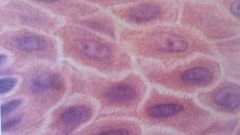
Made of thin cells that form sheets and act as a semi-permeable barrier between the inside and outside of a body. |
|
|
Types of Epithelial tissue: Columnar Epithelia. |

Made of columns of cells that line the small intestine, stomach, and glands. May secret mucus, have finger-like projections called cilia, and or absorb materials. |
|
|
Tissue: Muscle |
Designed to change their shape. Act by shortening or lenghtining. |
|
|
Types of Muscle tissue: Skeletal muscle |

Looks striped as its made up of cells that line up in the same direction. Attaches to bone allowing the body to move. Found in limbs and places where the body needs support (Ex: such as lower around the lower abdomen and back). |
|
|
Types of Muscle tisue: Smooth muscle. |
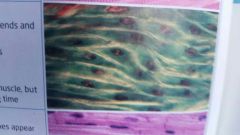
Do not have a striated appearence and made of cells that are tapered at both ends. Found in blood vessels and the walls of internal organs such as the esophagus and stomach. |
|
|
Types of Muscle tissue: Cardiac muscle. |
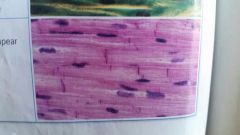
Made of cells whose nuclei sometimes appear to be between cells. Branched and unevenly striated. Found only in the heart. Contracts as a unit. |
|
|
Tissue: Nervous |
Made of cells called neurons which have finger-like projections to receive and transfer signals. Coordinates body actions. |
|
|
Types of Nervous tissue. ARE VARIED IN THEIR ACTION. |

-some relay signals from the Brian and spinal cord to muscles and glands. -others detect information from their environment like a hot stove or heat and trigger the body's responses. |
|
|
Tissues: Connective |
Strengthens , supports, protects cells and tissues. Consists of cells in an extracellular matrix that can range from a liquid (blood) yo elastic materials that can stretch (in ligaments) to mineral depsoits (bone). |
|
|
Types of connective tissue: Bone. |
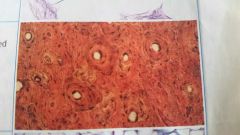
Made of cells surrounded by calcium-hardended tissue through witch blood vessels flow. Needed for support, movement, and protection. |
|
|
Types of connective tissue: fat. |
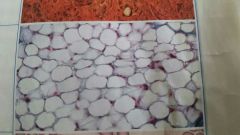
Made of large, tightly packed cells. Found under the skin and around organs. Needed for energy storage, padding and insulation. |
|
|
Types of connective tissue: Blood. |
Includes red and white blood cells and platelets within a liquid mix called plasma. Transports nutrients and oxygen. Clots when the skin is cut. Attacks invaders such as bacteria and viruses. |
|
|
Stem cells |
Unspeciallized cells in animals that can produce specialized cells. Mammals can only replace small amounts of tissues(bone, skin). Human organs are formed in the embryo and cannot be remade. Embryos possess totipotent stem cells which can become any type of cell. As development occurs cell become pluripotent which are capable of producing some but not all types of cells. Adult stem cells (after birth) can only produce specific types of cells (skin produces skin, bone produces bone). |
|
|
Ethical issues of using Embryonic stem cells( an unspeciallized cell that can become any one of an organisms body cells). |
Totipotent cells are found in embryos less than a week old. These cells can be kept in a lab and divide undifferentiated cells for up to a year. These cells can become any one of the approximate 300 different types of human cells. These cells must be taken from embryos outside the womb and cause the embryo to die. Some people consider this to be taking a human life. |
|
|
Other options (of using Embryonic stem cells) |
Adult stem cells have been changed into pluripotent stem cells. This change normally takes place using viruses that may damage the cells DNA. Cord blood banking. |
|
|
Types of technologies: X-Ray |
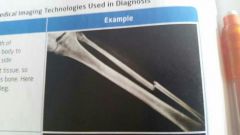
Produced by transmitting a wavelength of electromagnetic radiation through the body to expose photographic film on the other side. X-rays go through soft tissue so they are best used for hard tissue such as bone. |
|
|
Types of technologies: CT scan or CAT scan. |
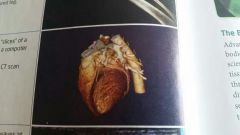
Produced by taking X-rays of very thin slices of a body part that can be reconstructed by a computer into a three-dimensional image. Example above: this three dimensional CT scan shows a healthy heart. |
|
|
Types of technologies: Ultrasound (medical sonography) |

Produced by directing high frequency sound waves at a part of the body, usually from a microphone attached to a computer. Shows real time movement of body parts like the heart; useful for watching organ function. Example above: this ultrasound image has been coloured to more clearly show blood flow through an artery. Blood flow is greatest when red and slowest when green. |
|
|
Types of technoligies: MRI scan ( magnetic resonance imaging). |
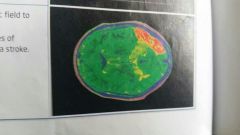
Produced using radio signals in magnetic field to create images of body parts. Example above: this MRI scan shows sites of bleeding in the brain, which has resulted in a stroke. |
|
|
Advances in technology (Endoscopy) |
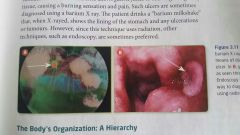
Endoscopy is where a tiny camera and a light attached to a flexible tube are inserted into the body. This provides options for diagnosis as well as treatment (shown in Figure B). The picture above shows two ways a stomach ulcer can be diagnosed. An ulcer is a hole in the mucous lining of the stomach or intestine, that allows gastric juices to start digesting body tissue, which is painful. Sometimes they are diagnosed by having the patient drink a barium milkshake, that, when X-rayed, shows the lining of the stomach and any ulcers or tumors (shown in Figure A). However this technique uses radiation so techniques such as Endoscopy are preferred. |
|
|
11 organ systems:Circulatory System |
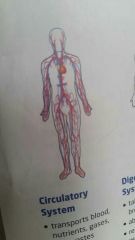
Transports blood, nutrients, gases, and wastes. |
|
|
11 organ systems: Digestive system |
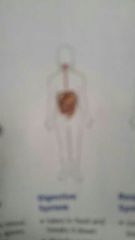
Takes in food and breaks it down. Absorbs nutrients. Removes solid waste from the body. |
|
|
11 organ systems: Respiratory system. |
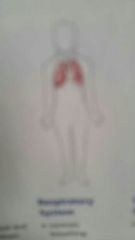
Controls breathing. Exchange gasses in lungs. |
|
|
11 organ systems: Excretory system. |
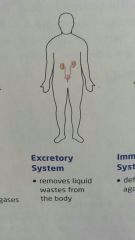
Removes liquid waste from the body. |
|
|
11 organ systems: Immune system |
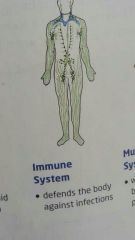
Defends the body against infections. |
|
|
11 organ systems: Muscular system. |
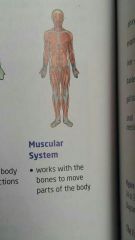
Works with the bones to move parts of the body. |
|
|
11 organ systems: Endocrine System |

Manufactory and releases hormones that act, along with the nervous system, to keep various body systems in balance. |
|
|
11 organ systems: Reproductive System |
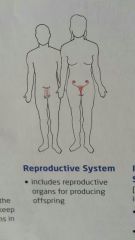
Includes reproductive organs for producing offspring. |
|
|
11 organ systems: Integumentary system. |
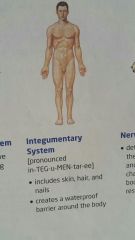
Includes skin, hair, and nails. Creates a waterproof barrier around the body. |
|
|
11 organ systems: Nervous System. |
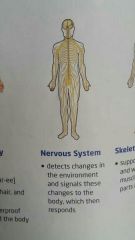
Detects changes in the environment and signals these changes to the body, which then responds. |
|
|
11 organ systems: Skeletal System. |

Supports, protects, and works with muscles to move parts of the body. |
|
|
Digestive system (In through the mouth) |
Digestion begins in the mouth. Teeth mechanically breaks down the food. Saliva contains the enzyme amylase which starts to break down the food chemically. Pharynx: tube food passes through when swallowed. Esophagus: Muscular tube that food enters from the pharynx. It contracts and relaxes to push food to the stomach (peristalisis). |
|
|
Digestive system: Into the stomach. |
The epithelial tissue in the stomach secretes gastric juices(hydrochloric acid and pepsin) The juices surround the food particles and continue to break them down chemically. Pepsin breaks down protein. Lining of stomach secretes mucus to prevent stomach wall from being broken down by acid juices. Nerves on the stomach can sense the presence of food. They signal to the stomach muscles to churn the stomach contents, continuing the mechinacle breakdown. |
|
|
Digestive system: Small intestine. |
Stomach contents enters the small intestine when the sphincter relaxes. The first Metre of the small intestine is called the duodenum- this is where the majority of digestion takes place. Duodenum is connected to the pancreas, liver and gall bladder. Each of these organs release additional enzymes into the duodenum to aid in completing chemical digestion. Digested food then moves through the length of the small intestine where it is absorbed into the body. The small intestine features many folds called villi and micro villi that maximize absorption into the blood stream. |
|
|
Digestive system: Large intestine |
The final organ in the digestive system. Has a larger diameter and shorter let than the small intestine. Functions: to absorb water, vitamins, and various salts from the digested food. Also responsible for eliminating undigested food(solid waste). |
|
|
Excretory system |
Responsible for liquid waste. Blood passes through kidneys and is filtered. Filtering forms urine containing water and un-needed salts. Urine is stored in the bladder. |
|
|
Respiratory system: Functions, How it works. |
Brings oxygen to the body and eliminates carbon dioxide. Works with the circulatory system. Muscles cause your diaphragm to contract and moves down and your rib cage moves out. This causes air to enter your lungs (inhale). When the muscles relax, your diaphragm moves up and ribs move in causing air to leave your lungs (exhale). |
|
|
Respiratory system: lobes |
The lungs are divided into different sections called lobes. The right lung has three lobes. The left has two. |
|
|
Respiratory system: Path of air |
In through nasal passages to pharynx. Pharynx to trachea. Then into branching tube called bronchi. Bronchi divide into smaller tube called bronchioles. After bronchioles air pass into tin sacs called alveoli. Alveoli is where gas exchange takes place with the blood stream. Oxygen is picked up by a protein in your blood cells called hemoglobin. Carbon dioxide is dropped off to the alveoli and takes the reverse trip out of the the respiratory system
|
|
|
Respiratory system: lung damage and gas exchange in other Organisms. |
Smoking damages lungs. Chemicals in smoke can cause cancer. Tar builds up overtime. Fish: water enters mouth and passes over gils. At the gills, oxygen diffuses into blood vessels and carbon dioxide diffuses out. |
|
|
Circulatory system: function and how it works. |
Transports nutrients and oxygen to cells. Carries waste away from cells and to appropriate organs for elimination. Heart is a muscle that can contract and relax. Contraction creates pressure that pushes blood through the body. Valves found along the way that prevent blood from flowing backwards. |
|
|
Circulatory system: parts |
Arteries move blood away from heart. Veins bring blood back to heart. Right atrium receives deooxygenated blood from body through inferior and superior vena cava. Right ventricle pumps deooxygenated blood to lungs through pulmonary vein. Left ventricle pumps oxygenated blood to body through aorta. |
|
|
Circulatory system: capillaries |
Small thin-walled blood vessels. Bring blood close to tissues so exchange can happen. |
|
|
Circulatory system: heart disease and stroke. |
There are approx. 70 000 heart attacks in Canada per year. Heart disease is caused by hypertension and arteriosclerosis. Arteriosclerosis: thickening of the artery walls due to cholesterol or other fatty substances(called plaque). Blood clots can form around the plaque. A blood clot can break free and block blood vessels. Blood clot in the heart: heart attack. Blood clot in the brain: stroke. |
|
|
Circulatory system: Fixing blockages |
Blockages can be widened using a technique called angioplasty. A balloon is inserted into the artery and then inflated, opening the vessel. |
|
|
Circulatory system: hearts in other Organisms. |
Open system: Blood empties into all parts of the body (insects). Closed system: Blood stays in arteries and veins (mammals and birds). Fish: one atrium, one ventricle. Amphibians: two atria, one ventricle. |
|
|
Lable the digestive system |
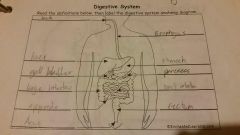
|
|
|
Lable the heart |
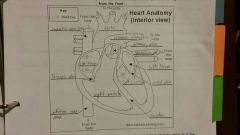
|
|
|
Lable the lungs |
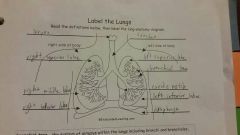
|
|
|
Lable the urinary system |

|
|
|
Biophotonics |
All procedures and devices that use various light technologies to work with living systems, including humans. Endoscopy is an example. |
|
|
Public health strategy |
A co-ordinate effort to track, research, and reduce the incidence of specific health problems in a population. Ex. The use of vaccinations. |
|
|
Vaccination |
The process of giving a vaccine by mouth or injection to provide active immunity against a disease. Ex. Worldwide vaccination program for smallpox has virtually eliminated the disease. |
|
|
Cancer screening |
Tests used to detect cancer cells at an early stage of the disease so that it can be treated more effectively. |
|
|
Fighting infectious diseases |
The body's first response to an invader is to send a flow of fluid containing white blood cells called phagocytes, and dissolved substances from the blood to the site of infection. This causes inflammation, swelling, and redness in the area. The job of the phagocytes is to fight infection. Any material that the body considers foreign and that stimulates this response is called an antigen. |

